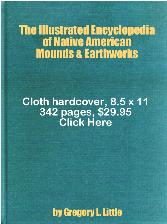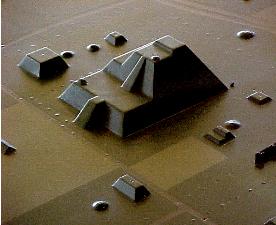 | ||||
 | ||||
ArchaeoTrek What is under Monk's Mound? by Dr. Greg Little The Cahokia (Illinois) Mound complex is the largest grouping of Native American mounds and certainly one of the most important mound sites in the country. The overwhelming centerpiece of the 2,200-acre park, which once contained 120 mounds, is known as "Monk's Mound." It is the largest earthen mound in America, standing at about 100-feet tall with a base covering 14 acres. (By contrast, the Great Pyramid of Giza covers just 13 acres.) In 1998 an intriguing mystery emerged at this mound, one that remains completely unexplained. From atop Monk's Mound one can see the skyline of St. Louis. The site was the major power point of the Mississippian-era Mound Building culture from A.D. 600 to about 1250. Within the 6 square miles of the center city it is believed that between 10,000 to 40,000 people lived. The mounds constructed at Cahokia contained over 55 million cubic feet of earth, carried, according to archaeologists, basketload by basketload. The very center of the city focused on Monk's Mound and a 200 acre area surrounded by a massive stockade fortress. Another 16 mounds were protected inside the stockade, which ran for 2 miles. The stockade was made from 20,000 one-foot thick logs standing 12 feet high. Every 70-feet along the stockade were protective bastions. It was an impressive city at its height. Excavations on the top of Monk's Mound revealed that an imposing 5000-square foot building once sat on its apex. The building was 105 feet long, 48 feet wide, and had walls 50 feet high. It is thought to have been the chief ruler's residence. Core samples and excavations performed on different areas of Monk's Mound have shown it was built over 250-years in a series of stages (generally believed to have been 14 distinct building periods each lasting about 18 years). Archaeological work at different areas of Cahokia have found hundreds of burials, sacrificed victims, pottery, points, burial goods, and countless artifacts. But the biggest surprise came in 1998 from work performed by nonarchaeologists. In the 1980's rain erosion began causing a slumping on the east and west sides of Monk's Mound and simple attempts to reduce the erosion and water seepage were repeatedly tried to no avail. In January 1998 a construction drilling team was brought in to make five drains into the base of the west side of the mound's base. While drilling the fifth hole, something unexpected was struck—stone—a lot of it. Stone that should not have been there. The drill bit first hit stone at a depth of 150-feet (horizontally) and 45-feet below the surface of the second terrace. From his experience drilling through stone, the drill operator related that it appeared to be sandstone or limestone. He continued drilling until the drill bit broke. By then he had gone through 32-feet of stone. The $5000 drill bit and an electronic sensor attached to it remain inside the hole to this day. In 1999 groung-penetrating radar was used at the site determining, not surprisingly, that there was a large, rectangular stone structure in the mound. However, two other densely packed rectangular structures (probably made of stone) were also found. One was above the large chamber the drill had tried to enter and the other was below it. Archaeologist William Woods of Southern Illinois University stated that it was a "dramatic find, it's so unexpected that it never has entered your mind before." Woods continued, "Stone does not occur naturally at Cahokia so any stone would have had to be brought by humans. Stone is uncommon at excavations there." The explanation for the three stone chambers at Monk's Mound likely relates to the finding that the mound was built in stages. It is probable that each of these three chambers are large burial crypts that were made after an important ruler died. After each chamber was constructed and burial ceremonies were performed, the mound was enlarged and heightened thereby covering the chamber. However, this was more characteristic of the earlier Adena and Hopewell cultures—but we'll perhaps never know. America archaeology laws and the lack of adequate funding will keep the mystery intact. But the size of these chambers and their undisturbed state would indicate that within them are the greatest archaeological treasures in North America. And with those "treasures" there would be a lot of answers found to the many enigmas of America's Mound Builders.
| ||